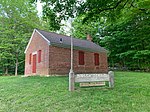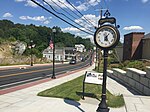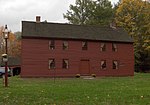Loomis-Pomeroy House
Federal architecture in ConnecticutGreek Revival houses in ConnecticutHouses in Coventry, ConnecticutHouses on the National Register of Historic Places in ConnecticutNational Register of Historic Places in Tolland County, Connecticut

The Loomis-Pomeroy House is a historic house at 1747 Boston Turnpike (United States Route 44) in Coventry, Connecticut. Built about 1833, it is a fine local example of transitional Federal-Greek Revival architecture, with important family associations in local history. The house was listed on the National Register of Historic Places in 1994.
Excerpt from the Wikipedia article Loomis-Pomeroy House (License: CC BY-SA 3.0, Authors, Images).Loomis-Pomeroy House
Boston Turnpike,
Geographical coordinates (GPS) Address Nearby Places Show on map
Geographical coordinates (GPS)
| Latitude | Longitude |
|---|---|
| N 41.797777777778 ° | E -72.376388888889 ° |
Address
Boston Turnpike 1717
06238
Connecticut, United States
Open on Google Maps








